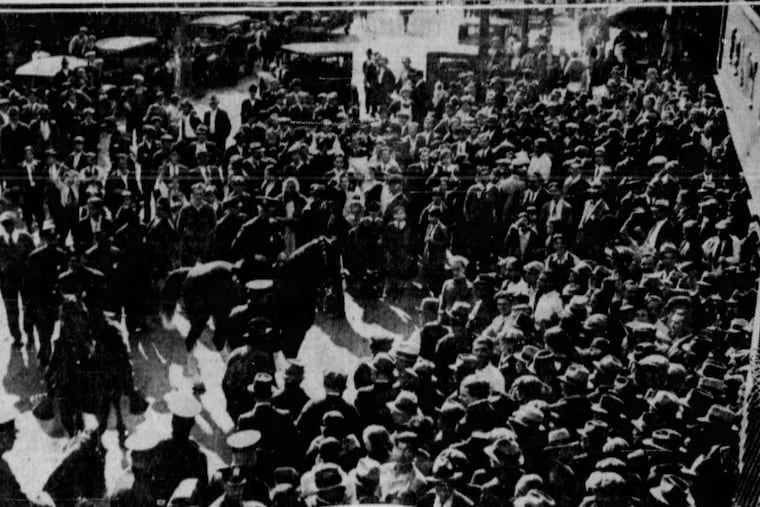Priest held hostage by angry parishioners of closing South Philly church
The congregation went all out in an effort to prevent a merger.

Prayers went unanswered, and the parishioners were losing faith.
Cardinal Dennis Joseph Dougherty's orders were being carried out: Our Lady of Good Counsel at 816 Christian St., a predominantly Italian-speaking church serving a loyal base of working-class immigrants, was to merge with the traditionally Irish- and English-speaking St. Paul's Church, one block away.
Despite its loyal congregation, the Augustinian church was an easy target. It was built in 1899 to serve the large influx of Italian immigrants. But by the 1930s, Good Counsel had the smallest footprint in a cluster of five Catholic churches around the Italian Market. The Italian population in the area was shrinking. And the Great Depression left the church struggling financially.
But to parishioners, it was more than a church. It was a community keystone. And they were losing not only their church, but also its religious order, with diocesan authority being imposed instead.
So thousands gathered outside on May 3, 1933, the eve of Good Counsel's closure. The throng paraded through South Philadelphia. A band played as people marched and stopped traffic.
"We want our Augustinian fathers," banners proclaimed in Italian and English.
The pastor explained that the decision was out of their hands. Protesters reportedly threatened his life, claiming he was betraying his congregation. "We'll kill him!" members of the crowd reportedly shouted.
The church's five priests had been ordered to temporarily join St. Nicholas of Tolentine Church on Ninth Street near Morris. They were supposed to go there at midnight, when the merger became effective.
Four managed to leave through a rear door while police attracted the crowd's attention to the front entrance.
One did not.
The crowd pushed its way into the church. The Inquirer reported that the group tolled the bell until it cracked. Another group carried a 12-foot crucifix from an altar to the street. They asked Pope Pius XI to intercede.
They found the Rev. Simpliciano Gatt, and surrounded him.
A statement from a protest spokesperson said:
"Father Gatt is here and we love him and we will not let him leave … he is our prisoner."
The siege
The next day, "husky" bodyguards kept Gatt under constant surveillance, holding him in captivity in a cell-like office on the church's third floor as the protest continued outside, the Inquirer reported.
"We are going to keep up this protest until Doomsday," one man told the crowd. "And from now until we win, every day in our church is a Holy Day. The church will be open at all hours, and we want everybody in it day and night."
Gatt, pale-faced but gentle, led worshippers in prayers and hymns, and concluded with a blessing. The Inquirer noted that protesters had half-ordered, half-requested the priest to do so, and he complied.
"Not only is he a prisoner," a protest spokesperson told the newspaper. "But he will continue as a prisoner indefinitely — that is, until from the standpoint of the parishioners, the order evacuating Our Lady of Good Counsel, and the transfer of the Augustinian fathers to St. Nicholas of Tolentino, is rescinded."
The police were careful to say that if Gatt wanted to get out, they would get him out. But officers didn't want to use violence, which would escalate the situation further, potentially leave many injured, and desecrate a sanctuary. Police were instructed not to use force against the mob, which at times ballooned to between 4,000 and 5,000 people.
The Inquirer described Gatt as a pathetic figure trapped in his tiny office, but understanding, even sympathetic, toward his captors.
"I understand these people," the priest told the newspaper. "They are my friends. They are not going to harm me. I do not fear them. But I have been ordered to leave, but …"
He spread his arms wide in an eloquent gesture. "I cannot. I am — yes, I am what you would call a prisoner."
Assimilation
On Oct. 24, 1933, nearly five months after Gatt was taken hostage, he was released and sent to Vineland, N.J.
He was set free after parishioners learned that the priest might be suspended from the order if he remained unable to conform to some of its regulations. In Vineland, he became assistant rector of St. Mary's Catholic Church.
But the parishioners refused to surrender the property. Leaders of the resistance still occupied the building.
They went to court, but lost. The church closed the building.
According to Beyond History — The Times and Peoples of St. Paul's Roman Catholic Church, 1843 to 1993, by Celeste Anne Morello, Dougherty ordered Good Counsel's congregation to go to either St. Paul's or Annunciation of the Blessed Virgin Mary at 10th and Dickinson Streets, both English-speaking parishes.
"This was probably the underlying reason for Good Counsel's closing: the people needed to break with the Italian-speaking church," Morello wrote. "After all, Good Counsel's parishioners were living in this 'isolation' for over thirty years: it was time to assimilate with the rest of Philadelphia."
Most joined St. Paul's, but there was not complete acceptance. Morello wrote that coffins with embalmed bodies were shoved through the doors of St. Paul's rectory, and abandoned in the hallways and on the front steps.
They were sending a message: "Do a funeral," Morello wrote.
Before it was demolished, eventually becoming the driveway that is there now, the Good Counsel building was part of Southeast Catholic High School (later known as St. John Neumann High School) and converted into a study hall, she wrote.
Years later, Morello added, men and women would still come to the site to genuflect and pray, in what was still their place of worship.
Search the archives for yourself and subscribe for full access.